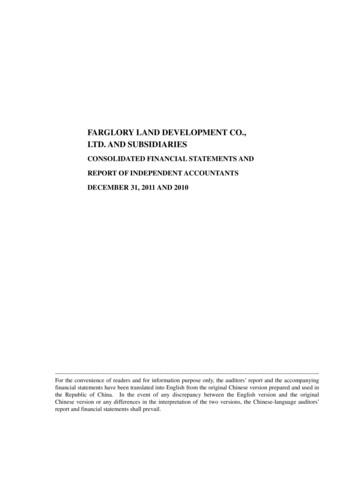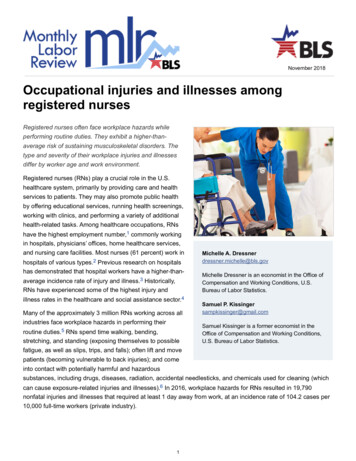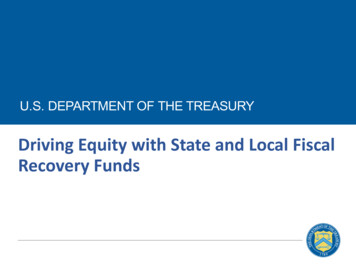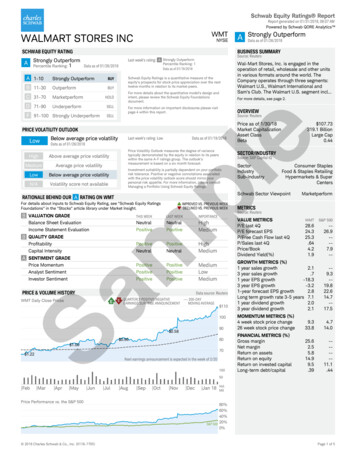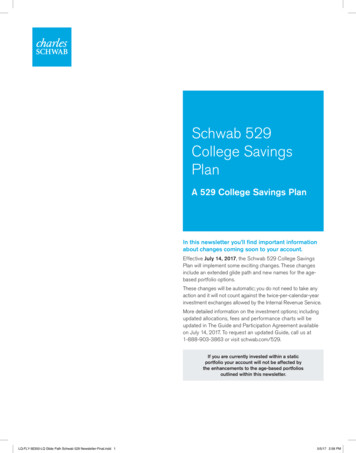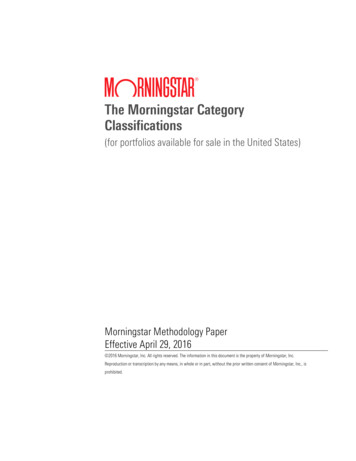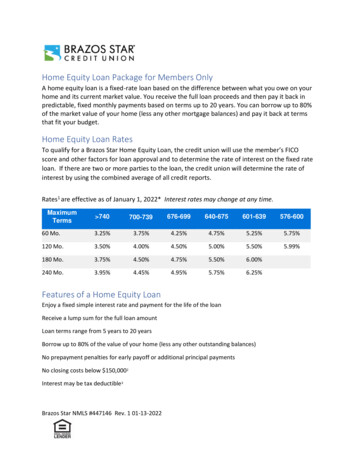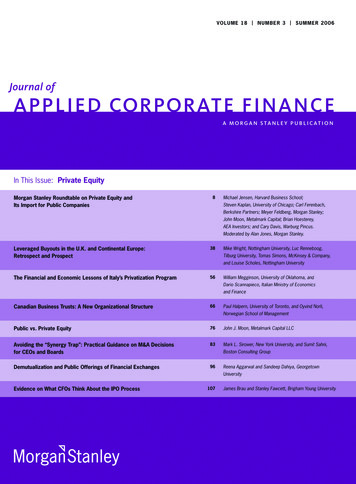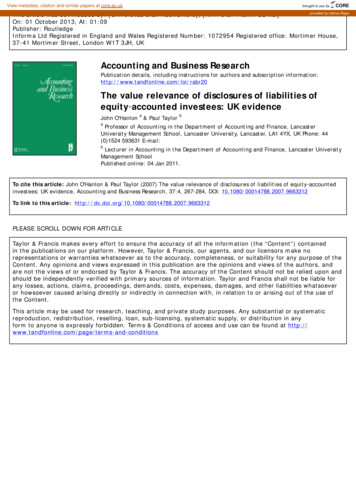
Transcription
View metadata, citation and similar papers at core.ac.ukbrought to you byCOREprovided by Udinus RepoThis article was downloaded by: [Universitas Dian Nuswantoro], [Ririh Dian Pratiwi SE Msi]On: 01 October 2013, At: 01:09Publisher: RoutledgeInforma Ltd Registered in England and Wales Registered Number: 1072954 Registered office: Mortimer House,37-41 Mortimer Street, London W1T 3JH, UKAccounting and Business ResearchPublication details, including instructions for authors and subscription he value relevance of disclosures of liabilities ofequity‐accounted investees: UK evidenceaJohn O'Hanlon & Paul TaylorbaProfessor of Accounting in the Department of Accounting and Finance, LancasterUniversity Management School, Lancaster University, Lancaster, LA1 4YX, UK Phone: 44(0)1524 593631 E-mail:bLecturer in Accounting in the Department of Accounting and Finance, Lancaster UniversityManagement SchoolPublished online: 04 Jan 2011.To cite this article: John O'Hanlon & Paul Taylor (2007) The value relevance of disclosures of liabilities of equity‐accountedinvestees: UK evidence, Accounting and Business Research, 37:4, 267-284, DOI: 10.1080/00014788.2007.9663312To link to this article: ASE SCROLL DOWN FOR ARTICLETaylor & Francis makes every effort to ensure the accuracy of all the information (the “Content”) containedin the publications on our platform. However, Taylor & Francis, our agents, and our licensors make norepresentations or warranties whatsoever as to the accuracy, completeness, or suitability for any purpose of theContent. Any opinions and views expressed in this publication are the opinions and views of the authors, andare not the views of or endorsed by Taylor & Francis. The accuracy of the Content should not be relied upon andshould be independently verified with primary sources of information. Taylor and Francis shall not be liable forany losses, actions, claims, proceedings, demands, costs, expenses, damages, and other liabilities whatsoeveror howsoever caused arising directly or indirectly in connection with, in relation to or arising out of the use ofthe Content.This article may be used for research, teaching, and private study purposes. Any substantial or systematicreproduction, redistribution, reselling, loan, sub-licensing, systematic supply, or distribution in anyform to anyone is expressly forbidden. Terms & Conditions of access and use can be found at ns
267Accounting and Business Research, Vol. 37. No. 4. pp. 267-284. 2007Downloaded by [Universitas Dian Nuswantoro], [Ririh Dian Pratiwi SE Msi] at 01:09 01 October 2013The value relevance of disclosures ofliabilities of equity-accounted investees:UK evidenceJohn O’Hanlon and Paul Taylor*Abstract—This study examines the value relevance of mandated disclosures by UK firms of the investor-firmshare of liabilities of equity-accounted associate and joint venture investees. It does so for the six years followingthe introduction of FRS 9: Associates and Joint Ventures, which forced a substantial increase in such disclosuresby UK firms. Since the increased disclosure requirements were partly motivated by concern that single-line equityaccounting concealed the level of group gearing, and in light of previous US results, it is predicted that the mandated investee-liability disclosures have a negative coefficient in a value-relevance regression. The study also examines whether value-relevance regression coefficients on investee-liability disclosures are more negative for jointventures than for associates and whether they are more negative in the presence of investor-firm guarantees of investee-firm obligations than in the absence of such guarantees. The study reports that the coefficient on all investeeliability disclosures taken together has the predicted negative sign, and is significantly different from zero. It findslittle evidence that the negative valuation impact of liability disclosures is stronger for joint venture investees overall than for associate investees overall, or stronger for guarantee cases overall than for non-guarantee cases overall.There is, however, some evidence that the impact for joint venture guarantee cases is stronger than that for jointventure non-guarantee cases and stronger than that for associate guarantee cases.Key words: Equity accounting; joint ventures; associates; FRS 9; value relevance1. IntroductionBy testing for their value relevance, this study examines the usefulness to investors of mandateddisclosures by UK firms of the investor-firm shareof liabilities of equity-accounted associate andjoint venture investees. The study uses UK data forthe period from 1998 to 2003, immediately following the date of the introduction by the UK’sAccounting Standards Board (ASB) of FRS 9:Associates and Joint Ventures (ASB, 1997).Motivated in part by concern that single-line equity accounting was being used as an off-balancesheet-financing device which had the effect ofconcealing the level of group gearing (ASB,*The authors are, respectively, Professor of Accounting andLecturer in Accounting in the Department of Accounting andFinance, Lancaster University Management School. The studyhas benefited from the helpful comments of Steven Young,Pelham Gore, Pauline Weetman (editor) and an anonymousreferee, and of participants at a workshop at the University ofMelbourne. The authors thank the Centre for BusinessPerformance at the Institute of Chartered Accountants inEngland and Wales for financial support, and Victoria Wangand Noordad Aziz for assistance in the collection of data.Correspondence should be addressed to John O’Hanlon,Department of Accounting and Finance, Lancaster UniversityManagement School, Lancaster University, Lancaster, LA14YX, UK. Tel: 44 (0)1524 593631. Email: j.ohanlon@lancaster.ac.uk.This paper was accepted for publication in May 2007.1996), FRS 9 introduced for the first time strictthresholds governing disclosures by UK firms ofthe investor-firm share of the underlying gross assets and liabilities of equity-accounted investees,and forced a substantial increase in such disclosures. On the grounds that joint ventures are subject to joint control by the investor firm whereasassociates are only subject to its significant influence, FRS 9 also introduced a distinction betweenassociate investees and joint venture investees, requiring a higher and more prominent degree of disclosure in respect of joint ventures. We examinethe value relevance of the FRS 9-mandated disclosures of the liabilities of equity-accounted investees, which are the amounts by which the netinvestments in investees for which disclosures aremade would have to be grossed up to give the investor-firm share of the gross assets and liabilitiesof those investees. In light of the concerns aboutconcealment of group gearing that partly motivated the investee-liability disclosure requirements ofFRS 9 and in light of the findings of previous USresearch, we predict that the mandated disclosuresare negatively associated with the market value ofequity of the investor firm, and therefore have anegative coefficient in a value-relevance regression. In light of the possibility that the creditors ofjoint ventures might be more likely than those ofassociates to have explicit or implicit recourse to
Downloaded by [Universitas Dian Nuswantoro], [Ririh Dian Pratiwi SE Msi] at 01:09 01 October 2013268the assets of the investor firm and in light of thegreater and more prominent disclosure that FRS 9required for joint ventures relative to associates,we also examine whether the value-relevance regression coefficient on investee-liability disclosures is more negative for joint ventures than forassociates. Furthermore, because of the recourse tothe assets of the investor firm conferred by an investor-firm guarantee of investee-firm obligations,and in light of the findings of previous US research, we examine whether the value-relevanceregression coefficient on investee-liability disclosures is more negative in the presence of investorfirm guarantees than in the absence of suchguarantees.The findings of the study indicate that disclosures of liabilities of equity-accounted investees,which enable equity-accounted net investments tobe grossed up by financial statement users, arenegatively associated with the market value of equity of the investor firm. This is consistent with theconcerns about off-balance-sheet financing thathelped motivate the requirement for such disclosures under FRS 9. The study finds little evidencethat the negative valuation impact of liability disclosures is stronger for joint venture investeesoverall than for associate investees overall, orstronger for guarantee cases overall than for nonguarantee cases overall. There is some evidencethat the impact for joint venture guarantee cases isstronger than that for joint venture non-guaranteecases and stronger than that for associate guarantee cases.The remainder of the paper is organised as follows. Section 2 gives the background to the study,outlining relevant issues relating to accounting forassociates and joint ventures and the results of related research. Section 3 describes the research design. Section 4 gives details of the data used in thestudy. Section 5 reports the results. Section 6 concludes.2. BackgroundThis section provides background for the empirical work reported in the study. Subsection 2.1 outlines the history of the accounting for investmentsin associates and joint ventures in US, international and UK generally accepted accounting practice(GAAP), with particular reference to the disclosure of the gross assets and liabilities of equity-accounted investees and to the provisions of the UKaccounting standard FRS 9. Subsection 2.2 outlines related research. Subsection 2.3 summarisesthe section.1 See FRS 9: Associates and Joint Ventures (ASB, 1997),IAS 28: Investments in Associates (IASB, 2003a) and IAS 31:Interests in Joint Ventures (IASB, 2003b) for definitions of associates and joint ventures in UK and international GAAP.ACCOUNTING AND BUSINESS RESEARCH2.1. Accounting for associates and joint venturesAssociate and joint venture investees are eachsubject to an important degree of influence by theinvestor firm, where the influence falls short of thecontrol that would classify the investee as a subsidiary of the investor firm. In the case of a jointventure, the investor firm and one or more otherparties exercise joint control under a contractualarrangement; in the case of an associate, the investor firm merely exercises significant influence.1Some accounting regimes have drawn a distinctionbetween the two types of investee, and others havenot.Until the early 1970s, an investment by one firmin another where the investee firm was not a subsidiary of the investor firm was generally accounted for at cost in the balance sheet, and income wasrecognised when a dividend was received from theinvestee. The inadequacies of such accounting forwhat might be vehicles for important activitiesmotivated the development of a more informativemethod of accounting for investee firms overwhich the investor firm had significant influenceshort of control. Under this method, termed the equity method, the investee is accounted for in theinvestor firm’s balance sheet as a single-line itemcomprising cost plus the investor-firm share of thepost-acquisition change in the investee’s equity,and in its income statement as the investor-firmshare of aggregated components of investee net income. Use of the method was pioneered by theRoyal Dutch Shell group in 1964 (Ernst & YoungLLP, 2001), and was introduced into US GAAPand UK GAAP in 1971. The relevant US accounting standard was APB Opinion No. 18: The equitymethod of accounting for investments in commonstock (Accounting Principles Board, 1971), andthe relevant UK accounting standard was initiallySSAP 1: Accounting for Associated Companies(ASC, 1971). Subsequently, international accounting standards incorporated the method in IAS 28:Investments in Associates (IASB, 2003a) andIAS 31: Interests in Joint Ventures, (IASB, 2003b),which were first issued in 1988 and 1990, respectively.Concern has been expressed in some quartersthat single-line equity accounting may reflect insufficient information about the activities of investee firms, a particular concern being that suchaccounting could be used to conceal the level ofinvestor-group debt (Bierman, 1992; ASB, 1994;ASB, 1996; Crichton, 1996; Johnson and Holgate,1996). This has led to the development of variousmethods for reflecting in the financial statementsof investor firms more detailed information fromthe underlying income statements and balancesheets of equity-accounted investees. These methods include proportionate consolidation, where theinvestor-firm share of investee-firm financial-
Downloaded by [Universitas Dian Nuswantoro], [Ririh Dian Pratiwi SE Msi] at 01:09 01 October 2013Vol. 37 No. 4. 2007statement line items is merged with the investorfirm line items, the expanded equity method,where the investor-firm share of investee-firm lineitems appears in the investor firm’s financial statements but is not merged with the investor-firm lineitems, and note disclosures. There has been muchdebate about how far along the spectrum from single-line equity accounting to proportionate consolidation regulators should go with regard toassociates and joint ventures, with single-line equity accounting being seen by some as reflectingan inadequate amount of information about important activities and proportionate consolidationbeing seen by some as implying a greater degree ofcontrol than is actually exercised (ASB, 1994;Milburn and Chant, 1999). Differences of opinionhave been reflected in differences across regimesin accounting for associates and joint ventures.With regard to disclosure of liabilities of equityaccounted investees, the US’s APB Opinion No. 18states that, where material, it might be necessary todisclose information on the assets and liabilities ofthe investee firm. Materiality thresholds are notdefined by APB Opinion No. 18, but have been defined for SEC registrants by the SEC’s RegulationS-X. This requires note disclosure of summarisedinformation on assets, liabilities and results of operations of equity-accounted investees that exceedspecified materiality thresholds, and the filing ofseparate financial statements of equity-accountedinvestees that exceed higher materiality thresholds(Accounting Series Release 302: SeparateFinancial Statements Required by Regulation S-X,SEC, 1981).2 No distinction is drawn between associates and joint ventures with regard to the required method of accounting or the requireddisclosures.International GAAP has distinguished betweenthe method of accounting for associates and themethod of accounting for joint ventures, includingwith regard to the way in which investee liabilitiesare reflected in investor-firm financial statements.When first issued in 1988, IAS 28: Investments inAssociates required associates to be accounted forby the equity method, with no requirement for disclosure of liabilities of associates. However, thecurrent version of the standard, effective for accounting periods beginning on or after 1 January2005, requires disclosure of summarised financialinformation of all associates, including their aggregate assets, liabilities, revenue and net income(IASB, 2003a). IAS 31: Interests in Joint Venturesrequires that joint ventures be accounted for eitherby proportionate consolidation, which is the preferred method, or by the equity method as forassociates. However, the IASB has recently sig2 The relevant Regulation S-X rules are 1-02(w), 3-09 and4-08(g).269nalled its intention to eliminate the main differencebetween IAS 31 and the corresponding US GAAPprovisions by removing the option to account forjoint ventures by proportionate consolidation andrequiring that they be accounted for by the equitymethod (IASB, 2007). This will remove a significant distinction between the methods of accounting for associates and for joint ventures, althoughdisclosures may continue to be made separately foreach class of investee.Similar to APB Opinion No. 18, the UK’s SSAP 1required that, if materially relevant from the perspective of the investor firm, information on theassets and liabilities of an equity-accounted investee should be disclosed in the investor firm’s financial statements. However, no materialitythresholds were defined and, for the period duringwhich SSAP 1 was in force, disclosure of such information by UK firms was rare (ASB, 1997, appendix 3, paragraph 3). During the 1990s, therewas concern that this might be allowing equityaccounted investees to be used as a means of concealing debt (ASB, 1994; ASB, 1996; Crichton,1996; Johnson and Holgate, 1996). Furthermore,on the grounds that joint ventures and associatesare different in that the former is subject to jointcontrol by the investor firm whereas the latter ismerely subject to its significant influence, therewas some debate as to whether joint venturesshould be treated differently from associates.These concerns were reflected in the developmentby the UK’s ASB of FRS 9: Associates and JointVentures, which came into effect for accountingperiods ending on or after 23 June 1998. This defined for the first time strict thresholds governingthe disclosure by UK firms of the investor-firmshare of the liabilities of equity-accounted investees, bringing about a significant increase insuch disclosure. It also introduced a clear distinction between associates and joint ventures, requiring a higher and more prominent degree ofdisclosure for the latter.The disclosures required by FRS 9 took threeprincipal forms. First, firms were required to account for all joint ventures by the gross equitymethod, whereby the investor-firm share of the investee firm’s gross assets and gross liabilities appeared on the face of the investor firm’s balancesheet and the investor-firm share of the investeefirm’s sales revenue appeared on the face of the investor firm’s income statement. Second, if the investor-firm share of one or more designated itemsfor aggregate associates or for aggregate joint ventures exceeded 15% of the corresponding item forthe investor firm, a 15% materiality disclosure forthat class of investee was required. The designateditems were (i) gross assets, (ii) gross liabilities,(iii) sales revenue and (iv) the three-year averageof operating profits. If the 15% threshold was ex-
Downloaded by [Universitas Dian Nuswantoro], [Ririh Dian Pratiwi SE Msi] at 01:09 01 October 2013270ceeded, the investor firm had to disclose in aggregate its share of the following items of the investees: sales revenue, fixed assets, current assets,liabilities due within one year, and liabilities dueafter one year. Third, if for any individual associate or joint venture the investor-firm share of anyof the four designated items exceeded 25% of thecorresponding item for the investor firm, a 25%materiality disclosure was required. In this case,the investor firm had to disclose its share of thefollowing in respect of the individual investee:sales revenue, profit before tax, taxation, profitafter tax, fixed assets, current assets, liabilities duewithin one year, liabilities due after one year.It is notable that, although it was issued at a timeof increasing support by the ASB for theInternational Accounting Standards Committee(IASC) harmonisation project, FRS 9 differedfrom the then current international accountingpractice, as reflected in IAS 28 and IAS 31, in anumber of significant respects. Areas of differenceincluded the requirement in FRS 9 to disclose information about liabilities of associates, at a timewhen no such requirement existed in IAS 28, thelack of any provision within FRS 9 for proportionate consolidation, at a time when IAS 31 stronglyencouraged its use in accounting for joint ventures,the definition of significant influence, criteria forexclusion from the requirement to apply equity accounting, the reporting of components of equityaccounted income, the treatment of loss-makingequity-accounted investees, and the definition oftypes of joint venture (Ernst & Young LLP, 2001,ch. 7, Section 6). It is also notable that the revisionto IAS 28 that post-dated FRS 9, requiring the disclosure of associate liabilities for accounting periods beginning on or after 1 January 2005, and theproposed revision to IAS 31, requiring joint ventures to be accounted for by the equity method, aremoving international accounting practice with regard to the disclosure of the liabilities of equity-accounted investees closer to the FRS 9 position.3However, it should also be noted that the proposedchange to IAS 31 runs counter to the path taken byFRS 9 in one respect, in that it substantially reduces the difference between the method used toaccount for investments in joint ventures and thatused to account for investments in associates.2.2. Related researchA number of previous studies examine the usefulness to investors of accounting disclosures re3Unlike the international standards, FRS 9 made distinctions with regard to materiality, which resulted in liabilities ofsome non-material associates not being disclosed and detailsof particularly material associates and joint ventures being disclosed individually. Also, it required that disclosures with regard to aggregate joint ventures be made on the face of thebalance sheet using the gross equity method.ACCOUNTING AND BUSINESS RESEARCHgarding associates and joint ventures, focusing ontheir value relevance as measured by associationwith market value, on their risk relevance as measured by association with risk measures, or on theirforecasting relevance as measured by their contribution to the forecasting of accounting numbers.Motivated by the possibility that US GAAP’slack of distinction between associates and jointventures might limit the usefulness of US accounting data, Soonawalla (2006) examines the relevance to investors of associate and joint venturedisclosures in Canada and the UK for theperiods 1995–2000 and 1997–2000, respectively.Relevance is measured both by forecasting relevance and by value relevance. The focus is on thepotential incremental relevance of (i) equity-accounted income disaggregated into associate andjoint venture components, beyond equity-accounted income of associates and joint ventures takentogether, (ii) single-line equity-accounted net investment disaggregated into associate and jointventure components, beyond the single-line equity-accounted net investment in associates and jointventures taken together, and (iii) joint venture revenues and expenses, beyond joint venture earnings. The study finds evidence that disaggregatedassociate and joint venture information is forecasting-relevant and value-relevant beyond aggregateinformation, and therefore suggests that failure todistinguish between associates and joint venturesmay result in the concealment of valuable information. It does not consider the effect of investee-liability disclosures or of investor-firm guarantees.Lourenço and Dias Curto (2006), using UK datafrom 1999 to 2004, report that investors value thegross assets of joint venture investees differentlyfrom investor-firm gross assets and that they valuethe liabilities of joint venture investees differentlyfrom investor-firm liabilities. The study does notconsider associates or the effect of investor-firmguarantees.For Canadian firms for the period from 1995 to2000, Kothavala (2003) examines whether information on joint venture investees presented usingproportionate consolidation, which reflects the liabilities of joint venture investees, explains marketrisk measures better (is more risk-relevant) thaninformation based on single-line equity accounting, which does not. The study is motivated in partby suggestions that the use of equity accountingrather than proportionate consolidation, by failingto reflect liabilities of investees, may allow thoseinvestees to be used as an off-balance-sheet-financing device (Bierman, 1992). The results of thestudy are mixed. Accounting numbers based onproportionate consolidation are more risk-relevantthan those based on single-line equity accountingwhen risk is measured using price volatility, butare less risk-relevant when risk is measured using
Downloaded by [Universitas Dian Nuswantoro], [Ririh Dian Pratiwi SE Msi] at 01:09 01 October 2013Vol. 37 No. 4. 2007bond ratings. A related study by Stolzfus and Epps(2005) uses US data for the period from 1996 to1999 to examine whether accounting data constructed as if joint ventures are accounted for byproportionate consolidation explain risk premiabetter than reported accounting data based on theequity method. The study reports that, althoughproportionate consolidation does not dominate equity accounting in explaining risk premia for alljoint ventures taken together, it does so for jointventures where obligations are guaranteed by theinvestor firm.Graham, King and Morrill (2003), usingCanadian data for the period from 1995 to 2001,find that reported accounting data, in which jointventures are accounted for by proportionate consolidation, have greater forecasting relevance thanaccounting data constructed as if joint ventures areaccounted for by the equity method.Bauman (2003) uses a sample of 150 US firmyears for the years 2000 and 2001 to examine thevalue relevance to investors in the investor firm ofdisclosures of the liabilities of equity-accountedinvestees, which he terms off-balance-sheet activities concealed by the equity method of accounting. Because of the possibility that investors in theinvestor firm might place a higher weight on investee-liability disclosures if there is an investorfirm guarantee of investee-firm obligations, adistinction is drawn between guarantee cases andnon-guarantee cases. No distinction is drawn between joint ventures and other equity-accountedinvestees. In regression models in which the dependent variable is the market value of equity andexplanatory variables include investee-liabilitydisclosures, the coefficient on investee-liabilitydisclosures is negative both in guarantee cases andin non-guarantee cases, both in 2000 and 2001.Consistent with investors placing greater weighton investee-liability disclosures in the presence ofan investor-firm guarantee, the coefficient forguarantee cases is significant in both years whereas that for non-guarantee cases is significant inonly one year, and the guarantee coefficient is271lower (more negative) than the non-guarantee coefficient in both years.2.3. SummaryThe issues of whether and how to reflect in thefinancial statements of investor firms informationabout equity-accounted investees have been debated extensively and have generated a considerabledegree of regulatory activity, some of which isongoing at the time of writing. Prior research hasreported evidence on the value-relevance, risk-relevance and forecasting-relevance of such information, and has found that investors view informationabout equity-accounted investees differently depending upon whether it relates to associates or tojoint ventures and depending upon whether or notthere is an investor-firm guarantee of investee-firmobligations. A US study by Bauman (2003) hasfound a negative association between the marketvalue of the investor firm and disclosures of liabilities of equity-accounted investees, with the valuation impact being more pronounced in thepresence of guarantees than in the absence of guarantees.In this study, we use a sample of UK firm-years,substantially larger than that used in Bauman’s USstudy and drawn from the six years immediatelyfollowing the major increase in disclosure requirements brought about by FRS 9, to examine thevalue relevance to investors in the investor firm ofdisclosures of liabilities of equity-accounted investees. We also examine whether this differs between associates and joint ventures, and whether itdiffers between guarantee cases and non-guaranteecases.3. Research designThe main objective of this study is to examinewhether disclosures of the investor-firm share ofthe liabilities of equity-accounted investees arevalue-relevant to investors in the investor firm. Inorder to address this objective, the following regression model is estimated:(1)4 Market value of equity is measured on an ex-dividendbasis, in order to be consistent with the balance sheet. The adjustment by the total return on the firm’s shares for the threemonths after the balance sheet date gives a market value measure which (i) reflects information becoming available in thethree months following the balance sheet date, and (ii) is consistent with the balance sheet with respect to capital changesthat may have occurred in that three-month period.where: MVEit is the ex-dividend market value ofequity of the investor firm i at the balance sheetdate t, adjusted by the total return on the firm’sshares for the three months after that date;4 BVAi,t-1is the book value of assets of firm i at the previousbalance sheet date t-1, inclusive of its equity-accounted net investment in associates and/or joint
Downloaded by [Universitas Dian Nuswantoro], [Ririh Dian Pratiwi SE Msi] at 01:09 01 October 2013272ventures, and is used to scale all variables in themodel other than dummy variables; ILDit is theFRS 9-mandated investee-liability disclosure inrespect of material associates and all joint ventures, taken together; BVAit is the book value of assets of firm i at the balance sheet date t, inclusiveof its equity-accounted net investment; BVLit is thebook value of liabilities of firm i at the balancesheet date t, inclusive of any equity-accounted netliability position recorded within provisions; NIit isthe net income of firm i for the period ended at thebalance sh
Performance at the Institute of Chartered Accountants in England and Wales for financial support, and Victoria Wang and Noordad Aziz for assistance in the collection of data. Correspondence should be addressed to John O'Hanlon, Department of Accounting and Finance, Lancaster University Management School, Lancaster University, Lancaster, LA1 .
